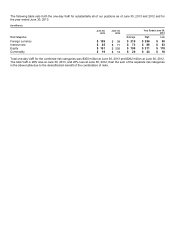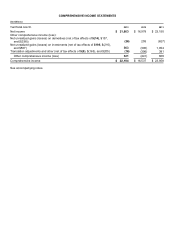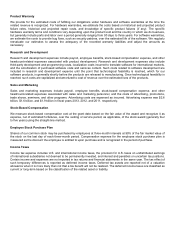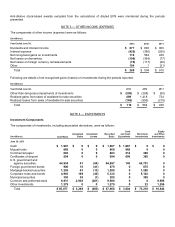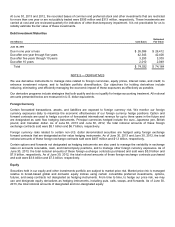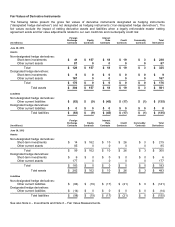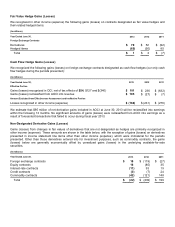Microsoft 2013 Annual Report Download - page 50
Download and view the complete annual report
Please find page 50 of the 2013 Microsoft annual report below. You can navigate through the pages in the report by either clicking on the pages listed below, or by using the keyword search tool below to find specific information within the annual report.Fair Value Measurements
We account for certain assets and liabilities at fair value. The hierarchy below lists three levels of fair value based on the
extent to which inputs used in measuring fair value are observable in the market. We categorize each of our fair value
measurements in one of these three levels based on the lowest level input that is significant to the fair value measurement
in its entirety. These levels are:
• Level 1 – inputs are based upon unadjusted quoted prices for identical instruments traded in active markets. Our
Level 1 non-derivative investments primarily include U.S. government securities, domestic and international
equities, and actively traded mutual funds. Our Level 1 derivative assets and liabilities include those actively
traded on exchanges.
• Level 2 – inputs are based upon quoted prices for similar instruments in active markets, quoted prices for
identical or similar instruments in markets that are not active, and model-based valuation techniques (e.g. the
Black-Scholes model) for which all significant inputs are observable in the market or can be corroborated by
observable market data for substantially the full term of the assets or liabilities. Where applicable, these models
project future cash flows and discount the future amounts to a present value using market-based observable
inputs including interest rate curves, credit spreads, foreign exchange rates, and forward and spot prices for
currencies and commodities. Our Level 2 non-derivative investments consist primarily of corporate notes and
bonds, mortgage-backed securities, U.S. agency securities, certificates of deposit, and foreign government
bonds. Our Level 2 derivative assets and liabilities primarily include certain over-the-counter option and swap
contracts.
• Level 3 – inputs are generally unobservable and typically reflect management’s estimates of assumptions that
market participants would use in pricing the asset or liability. The fair values are therefore determined using
model-based techniques, including option pricing models and discounted cash flow models. Our Level 3 assets
primarily comprise investments in certain corporate bonds and goodwill when it is recorded at fair value due to
an impairment charge. We value the Level 3 corporate bonds using internally developed valuation models,
inputs to which include interest rate curves, credit spreads, stock prices, and volatilities. In certain cases,
market-based observable inputs are not available and we use management judgment to develop assumptions to
determine fair value for these derivatives. Unobservable inputs used in all of these models are significant to the
fair values of the assets and liabilities.
We measure certain assets, including our cost and equity method investments, at fair value on a nonrecurring basis when
they are deemed to be other-than-temporarily impaired. The fair values of these investments are determined based on
valuation techniques using the best information available, and may include quoted market prices, market comparables,
and discounted cash flow projections. An impairment charge is recorded when the cost of the investment exceeds its fair
value and this condition is determined to be other-than-temporary.
Our other current financial assets and our current financial liabilities have fair values that approximate their carrying
values.
Financial Instruments
We consider all highly liquid interest-earning investments with a maturity of three months or less at the date of purchase to
be cash equivalents. The fair values of these investments approximate their carrying values. In general, investments with
original maturities of greater than three months and remaining maturities of less than one year are classified as short-term
investments. Investments with maturities beyond one year may be classified as short-term based on their highly liquid
nature and because such marketable securities represent the investment of cash that is available for current operations.
All cash equivalents and short-term investments are classified as available-for-sale and realized gains and losses are
recorded using the specific identification method. Changes in market value, excluding other-than-temporary impairments,
are reflected in OCI.
Equity and other investments classified as long-term include both debt and equity instruments. Debt and publicly-traded
equity securities are classified as available-for-sale and realized gains and losses are recorded using the



